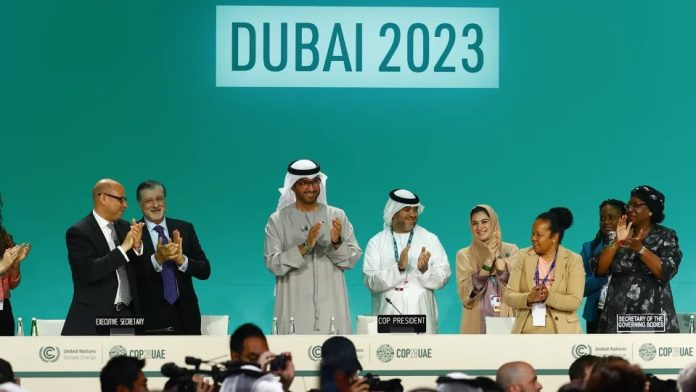The Conference of Parties (COP) is the supreme decision-making body of the United Nations Climate Change Framework Convention (UNFCCC). All States that are Parties to the Convention are represented at the COP28, where they assess the application of the Convention and any other legal instruments which the COP adopts and make decisions necessary to support the successful application of the Convention, including institutional and administrative arrangements.
India has made a significant impact on the global stage during the 28th United Nations Climate Change Conference (COP28) in Dubai, addressing itself as a leader of the global south. Prime Minister Narendra Modi, a dedicated advocate for environmental causes, didn’t hesitate to criticise wealthier nations for their unrestrained exploitation of nature.
Yet, amid this global leadership role, India faces a formidable internal challenge. As the world’s most populous nation, it grapples with the dual imperative of reducing its heavy reliance on coal while prioritizing the national priority of poverty alleviation.
Modi underscored the shared consequences of environmental exploitation, pointing out that India contributed 7.3% of global greenhouse gas emissions in 2022 despite being the third-largest carbon producer. This statistic takes on added significance considering India’s substantial population, making up 18% of the world’s total. Notably, India maintains a per capita emission considerably lower than developed nations.
The crux of India’s energy needs still hinges on coal, constituting 73% of its electricity in 2022. Modi defended this reliance, citing the necessity of coal for economic development and poverty reduction, while advocating for a fair share for developing countries in the global carbon budget.
Strategically, India refrained from signing declarations at COP28 that emphasized decarbonisation, taking a defensive stance, and perceiving negotiations as biased towards prosperous economies. The demand is clear – wealthy nations must demonstrate commitment to decarbonization before expecting the same from others.
Positioning itself as a leader for the global south, India stresses the unfairness of imposing a uniform 2050 deadline for net zero on all nations, considering the historical emissions of developed nations. This leadership role is seen as a response to address structural problems within the COP system.
Despite ongoing reliance on coal, India is making investments in decarbonization. The goal is to increase the share of solar and wind power in electricity production to 35% by 2032, up from 10.6% in 2022. Additionally, plans are in place to raise the share of non-fossil-fuel power in generation capacity from 43% to 50% by 2030.
India has rolled out a series of impactful initiatives to tackle environmental challenges and steer towards sustainable practices. Here’s a rundown of some noteworthy efforts:
- National Action Plan on Climate Change (NAPCC): Unveiled in 2008, NAPCC lays out eight national missions with a focus on specific areas like solar energy, energy efficiency, and sustainable agriculture to mitigate and adapt to climate change.
- International Solar Alliance (ISA): Since its inception in 2015, ISA has been a driving force in uniting solar-resource-rich nations to promote solar power. Clean India Mission (Swachh Bharat Abhiyan): Kicked off in 2014, this mission, while primarily centred on sanitation, also addresses environmental concerns by promoting responsible waste management and disposal.
- Smart Cities Mission: The Smart Cities Mission which was launched in 2015, aims to develop 100 sustainable and tech-driven cities and focuses on green technologies and efficient urban mobility to minimize the environmental impact.
- FAME India (Faster Adoption and Manufacturing of Hybrid and Electric Vehicles): FAME India has been having an aim since 2015, to electric and hybrid vehicles to reduce air pollution and to cut down the dependence on fossil fuels in transportation.
- UJALA (Unnat Jyoti by Affordable LEDs for All): UJALA encourages the use of energy-efficient LED bulbs, which further contribute to reduced energy consumption and promote sustainable lighting.
If India successfully fulfils its UNFCCC pledges and accelerates renewable energy deployment, projections indicate a slowdown and peak in carbon dioxide emissions in the 2030s. This aligns with India’s self-imposed 2070 deadline for achieving net-zero emissions.
Employing emissions intensity as a metric, India aims to reduce it by 45% below 2005 levels by 2030. The country remains cautious about adopting absolute emissions, prioritizing economic growth and developmental concerns. Some experts argue that India will consider total emissions only when it achieves high-income status.
At COP28, India played a pivotal role in adopting a landmark agreement on a loss and damage fund, designed to compensate low-income countries bearing the brunt of climate change damage. Emphasizing the urgent need for disbursement, countries clarified the fund’s handling to avoid delays.
India’s role at COP28 reflects a delicate balance between addressing developmental priorities, especially poverty reduction through coal, and its commitment to global climate goals. The outcomes of these negotiations are poised to shape India’s trajectory in the ongoing battle against climate change.
































